I think it is the pastel/soft colours, the simple lines that wrap around you and the minimalism that do it. No intrusive gearbox hump, no unnecessary trim, no invasive plastics and thin pillars that allow for lots of light.

You are using an out of date browser. It may not display this or other websites correctly.
You should upgrade or use an alternative browser.
You should upgrade or use an alternative browser.
1959 4cv Restoration in North Carolina USA
- Thread starter Stan W
- Start date
Thanks everyone! The headliner makes the seats look bad. Only the passenger seat has a seam that came loose, but the driver's seat feels like an elephant sat in it. The cushioning and maybe the springs are squashed. Does anyone know how the seat back is constructed? I will probably fix the passenger seat (if possible) and make new upholstery at some point. The next interior task is to remake all the cardboard pieces for the bits by the back seat, in front of the front doors and the B pillar part. I may put the door panels back, but I will make new ones.
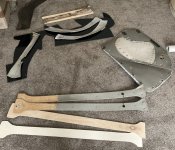

I took the passenger seat covers off to see how the upholstery was done. The seat back has burlap, jute and cotton batting. The seat cushion is made with burlap, jute, rubberized horse hair and cotton batting. I repaired the split seam in the passenger seat. The driver seat did not have completely worn springs, but some of the hogs rings had come loose and the front tube was bent - most likely due to the car being hit in the rear. There was also a assembly problem with the driver's seat, some of the spring coils were fastened partly below the zig zag supports. I fastened the springs properly. I put the seats back together and they are now in the car. The driver's seat is much more comfortable now. At some point soon, I will make new front seat upholstery using burlap, jute and a high quality foam. Here are pictures showing the upholstery under the seat covers.
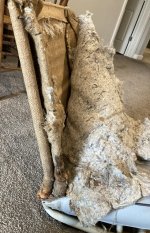
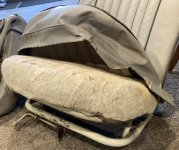
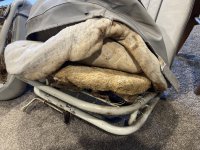



I think about that era they used seagrass? something like that for fill. I had an old BMW from the late sixties with the most comfortable seats. That is what I would go for if it is still about.
Later Dauphines and R8s had really comfortable seats. These used a "modern" foam with burlap between the springs and foam. The foam was much deeper in the center than the padding in earlier seats. It must have been a good quality foam, because I never saw one that sagged. There are many grades of foam - the good ones have high density - which is completely separate from compression (hardness of foam).
While I am figuring up the fabric and supplies needed to do the rest of the interior, I have been working on some other details. I wanted to replace the bearings in the front belt tensioner and finally got around to it. I was concerned about cracking the cast pulley, so I used pliers as a way to tap out the pulley evenly. The new bearings went in as they should. I had new front door limiting straps to install, but wanted to be able to remove the doors easily if desired. The solution was to enlarge the hole in the B pillar and make a piece to hold the strap that could be removed.
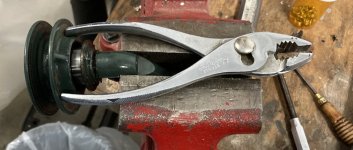
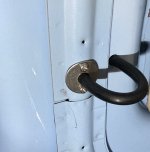


Here are a couple of pictures of the front brake upgrade (Dauphine front brakes).
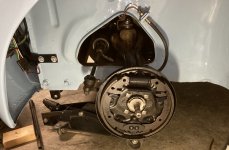
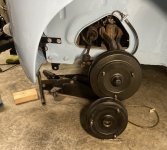
I received my upholstery materials yesterday - vinyl, jute, burlap, 1/4" sew foam (for seat pleats), 1/8" foam for door panels, 1" high density foam for seats (will be doubled for the lower cushions) piping (not pictured) and hog rings. All materials are the highest quality, ordered from a reputable upholstery supply company that gives all the specs on the material. Foam density determines how long the foam lasts - not to be confused with compression, which is how hard or soft it feels. I ordered one of the higher densities for all the foams. The cardboard backing pieces are being replaced with 1/8" ABS plastic. ABS is great because it can be heated to form it into shapes that are not flat. The B pillars are rounded on the inside, so a flat piece of board or other material doesn't work well. I mounted those pieces and heated them to the proper shape.
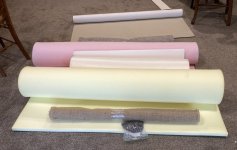
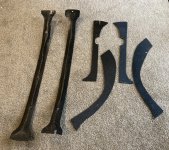


I received my upholstery materials yesterday - vinyl, jute, burlap, 1/4" sew foam (for seat pleats), 1/8" foam for door panels, 1" high density foam for seats (will be doubled for the lower cushions) piping (not pictured) and hog rings. All materials are the highest quality, ordered from a reputable upholstery supply company that gives all the specs on the material. Foam density determines how long the foam lasts - not to be confused with compression, which is how hard or soft it feels. I ordered one of the higher densities for all the foams. The cardboard backing pieces are being replaced with 1/8" ABS plastic. ABS is great because it can be heated to form it into shapes that are not flat. The B pillars are rounded on the inside, so a flat piece of board or other material doesn't work well. I mounted those pieces and heated them to the proper shape.


Couldn't you go front discs? I remember the Gordinis had all round disc brakes. I would be very tempted to get my hands on a set of those.
Not all the Gordinis so much as the last version of the Dauphine, the R1094 (and the last Gordinis, the R1095), for the last years 1965-1968. See "la Renault Dauphine de mon pere".Couldn't you go front discs? I remember the Gordinis had all round disc brakes. I would be very tempted to get my hands on a set of those.
The improvement given by the big drums is pretty dramatic so, if you have a pair, that's enough to hugely improve a 4CV. Yes, the discs are better again under real demand but for pottering about why bother (unless you have the disc stuff in your shed of course)? The early R8 hubs fit the Dauphine stub axles so it is a real bolt on modification, no more.
Probably. I remember these form childhood and all of them were "Gordini". I remember distinctly the rear badge took me a while to decipher (I was not even in school yet). In fact this is what people called them back then, completely oblivious about what that meant. If you had one, you would say, I've got a Gordini and people knew what that was. In fact I didn't even know the model was in fact Dauphine. Strange why this was the only model imported, but as you say, they were imported in the late sixties so maybe that was why they all had disc brakes.
I could have put discs on the 4cv, but I didn't happen to have any sitting around my garage. I'll probably accidentally find a set now that I have the upgrade done.
I have had Dauphines with disc brakes and drum brakes (later versions with wider front shoe linings). My experience was that they both stopped well. I couldn't tell the difference except that the handbrake was better with the drums. I eventually converted my disc brake 1094 to drums because the parts for the disc brakes were very expensive back in the 70's. A friend did the same with his Dauphine back then also. I never had any fade with the drum brakes - partly due to the gearing - the engine always did its' share of braking with my foot off the gas.
I have had Dauphines with disc brakes and drum brakes (later versions with wider front shoe linings). My experience was that they both stopped well. I couldn't tell the difference except that the handbrake was better with the drums. I eventually converted my disc brake 1094 to drums because the parts for the disc brakes were very expensive back in the 70's. A friend did the same with his Dauphine back then also. I never had any fade with the drum brakes - partly due to the gearing - the engine always did its' share of braking with my foot off the gas.
True, that. I had a hell of a time doing the brakes on my 11966 R10 (my first car) when I bought it in 91 for the same reason. Luckily I wasn't the first to have this problem and by then others had already figured out what parts fit from other cars. The handbrake mechanism was the worst offender but I did manage to get it working properly in the end. It would have been a lot easier with drums on the back, I agree but boy oh boy how that car stopped. Didn't accelerate very much, but I could outbrake pretty much anything else on the road back then.
Totally agree. The difference between my rear Dauphine drums on the 4CV and the R8 discs in handbrake effectiveness is just huge, I agree. If you get the disc handbrake adjusted right and lubricated (almost none....) it's more or less OK but it's no accident that the handbrake lever is a lot longer on the disc brake cars! Trouble was mostly poor maintenance and infrequent adjustment, which of course we all inherited from earlier owners!!True, that. I had a hell of a time doing the brakes on my 11966 R10 (my first car) when I bought it in 91 for the same reason. Luckily I wasn't the first to have this problem and by then others had already figured out what parts fit from other cars. The handbrake mechanism was the worst offender but I did manage to get it working properly in the end. It would have been a lot easier with drums on the back, I agree but boy oh boy how that car stopped. Didn't accelerate very much, but I could outbrake pretty much anything else on the road back then.
When I took the handbrake system apart in my R10, I found the cable was stuck on one side (after it splits to go to either wheel). Fixed that, then found the levers didn't operate. Freed those, found the pistons stuck. Freed those, found they leaked. Took calipers out, found corrosion under the seals. Pistons pitted. Cleaned, replaced seals, got some s/h good pistons, new seals, still had small leaks on both sides because the seal couldn't cover the pitting in the bottom of the channel. Eventually I found a pair of s/h clean calipers and that fixed it. A real mess and it took forever. Luckily the R10 doesn't really need much rear braking. In fact if you live in a cold snowy country you'd be better off if you could disconnect the rear brakes in winter.
Sounds normal for a neglected car! You can see why I use silicone fluid. The point of water absorbtion is just where you don't want it, where the seal bears against the alloy calliper. And in my view, changing the fluid regularly simply doesn't help as it doesn't flush behind the 'o' rings. It's easy AFTER you've sorted the car out and know what to do. Not easy before as you (and I) learned what was going on.When I took the handbrake system apart in my R10, I found the cable was stuck on one side (after it splits to go to either wheel). Fixed that, then found the levers didn't operate. Freed those, found the pistons stuck. Freed those, found they leaked. Took calipers out, found corrosion under the seals. Pistons pitted. Cleaned, replaced seals, got some s/h good pistons, new seals, still had small leaks on both sides because the seal couldn't cover the pitting in the bottom of the channel. Eventually I found a pair of s/h clean calipers and that fixed it. A real mess and it took forever. Luckily the R10 doesn't really need much rear braking. In fact if you live in a cold snowy country you'd be better off if you could disconnect the rear brakes in winter.
I think one can just use some sort of rubber lubricant or even silicone grease under the seals. You only need the tiniest film to make sure there's no water ingress. Modern silicone grease is miles ahead what was (not) available to the average person back in the sixties and even in the nineties. Still not cheap but for our use one tube should last a lifetime. Back then, finding silicone grease was not even imagined, let alone the price (today) for a tube equaled my monthly wage.
Problem with silicone fluid in cold climates is that any water that gets in is not absorbed (does not mix) in the fluid and you can have water drops freeze inside the system, who knows where.
Problem with silicone fluid in cold climates is that any water that gets in is not absorbed (does not mix) in the fluid and you can have water drops freeze inside the system, who knows where.
Yes, water definitely not miscible!! I just lube the o-rings with silicone brake fluid. The trick is polising the bottom of the grooves as most old callipers show some corrosion in there. I hadn't thought of the water freezing, but of course you are right there. Happily not my problem.I think one can just use some sort of rubber lubricant or even silicone grease under the seals. You only need the tiniest film to make sure there's no water ingress. Modern silicone grease is miles ahead what was (not) available to the average person back in the sixties and even in the nineties. Still not cheap but for our use one tube should last a lifetime. Back then, finding silicone grease was not even imagined, let alone the price (today) for a tube equaled my monthly wage.
Problem with silicone fluid in cold climates is that any water that gets in is not absorbed (does not mix) in the fluid and you can have water drops freeze inside the system, who knows where.
I have finally got the 4cv to the point I intended back when I purchased it. Everything is complete and installed (except the front mudguards). The interior panels are all complete and fitted. It was a bit tricky stretching the vinyl around the wheel wells to get a wrinkle free fit. I purchased a very good quality vinyl from an automotive upholstery supply (Albright's). It makes a big difference to have good materials - the vinyl has a wonderful soft feel (what you would expect from a good leather), is extremely durable, has good UV resistance and stretches well when installing.
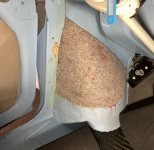
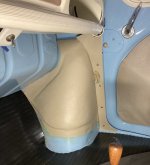
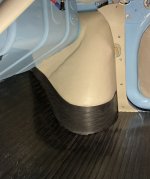
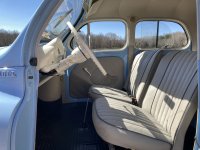
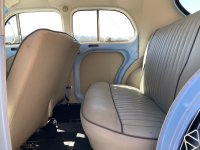
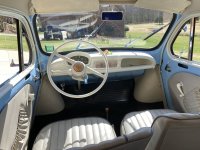
While the original front seats and front door panels look fairly good, I will be making new door panels and new front seat upholstery. Since I get in and out of the car a lot, the original thread will eventually break. I repaired a split seam on the passenger seat already. The other item I was not completely satisfied with is the gearbox. It was worn from lack of oil changes. I now have a very good 318 four speed gearbox from a 1962 Dauphine Gordini (thanks to Marvin McFalls). My plan is to replace the door panels, re-trim the front seats one at a time and then tackle the gearbox replacement. I would have preferred a 330 gearbox, but the 318 will be plenty strong for the 4cv. All the primary shaft teeth look very good.






While the original front seats and front door panels look fairly good, I will be making new door panels and new front seat upholstery. Since I get in and out of the car a lot, the original thread will eventually break. I repaired a split seam on the passenger seat already. The other item I was not completely satisfied with is the gearbox. It was worn from lack of oil changes. I now have a very good 318 four speed gearbox from a 1962 Dauphine Gordini (thanks to Marvin McFalls). My plan is to replace the door panels, re-trim the front seats one at a time and then tackle the gearbox replacement. I would have preferred a 330 gearbox, but the 318 will be plenty strong for the 4cv. All the primary shaft teeth look very good.
Looks just great! Congratulations on the work.I have finally got the 4cv to the point I intended back when I purchased it. Everything is complete and installed (except the front mudguards). The interior panels are all complete and fitted. It was a bit tricky stretching the vinyl around the wheel wells to get a wrinkle free fit. I purchased a very good quality vinyl from an automotive upholstery supply (Albright's). It makes a big difference to have good materials - the vinyl has a wonderful soft feel (what you would expect from a good leather), is extremely durable, has good UV resistance and stretches well when installing.
View attachment 202087View attachment 202088View attachment 202089View attachment 202090View attachment 202091View attachment 202092
While the original front seats and front door panels look fairly good, I will be making new door panels and new front seat upholstery. Since I get in and out of the car a lot, the original thread will eventually break. I repaired a split seam on the passenger seat already. The other item I was not completely satisfied with is the gearbox. It was worn from lack of oil changes. I now have a very good 318 four speed gearbox from a 1962 Dauphine Gordini (thanks to Marvin McFalls). My plan is to replace the door panels, re-trim the front seats one at a time and then tackle the gearbox replacement. I would have preferred a 330 gearbox, but the 318 will be plenty strong for the 4cv. All the primary shaft teeth look very good.
That thing looks so sweet you want to take a bite out of the steering wheel. You sure it's not made of candy?